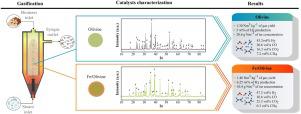Journal of Industrial and Engineering Chemistry ( IF 6.1 ) Pub Date : 2021-04-28 , DOI: 10.1016/j.jiec.2021.04.046 M. Cortazar , L. Santamaria , G. Lopez , J. Alvarez , M. Amutio , J. Bilbao , M. Olazar

|
The performance of Fe/olivine catalysts was tested in the continuous steam gasification of sawdust in a bench scale plant provided with a fountain confined conical spouted bed reactor at 850 °C. Olivine was used as catalyst support and loaded with 5 wt%Fe. The activity and stability of the catalyst was monitored by nitrogen adsorption-desorption, X-ray fluorescence spectroscopy, temperature programmed reduction, X-ray diffraction and X-ray photoelectron spectroscopy techniques, which were conducted before and after the runs. The fountain confined conical spouted bed performs well in the biomass steam gasification with primary catalysts. In fact, this reactor allows enhancing the gas-solid contact, and therefore the catalytic activity by avoiding the elutriation of fine catalyst particles. The uncatalysed efficiency of the gasification process, assessed based on the gas production and composition, H2 production, tar concentration and composition, and carbon conversion efficiency, was consideraby improved on the Fe/olivine catalyst, with tar reduction being especially remarkable (to 10.4 g Nm−3). After 140 min on stream, catalyst deactivation was particularly evident, as tar concentration increased to 19.9 g Nm−3 (90% of that without catalyst). However, Fe/olivine catalyst was still active for WGS and CH4 steam reforming reactions, with gas and H2 productions being 1.35 Nm3 kg−1 and 5.44 wt%, respectively. Metal iron oxidation to Fe3O4 caused catalyst deactivation, as the reaction environment shifted from oxidizing to reducing conditions due to operational limitations.
中文翻译:

铁/橄榄石在喷泉式密闭喷头床反应器中作为生物质蒸汽气化的主要催化剂
Fe /橄榄石催化剂的性能是在配备了喷泉密闭锥形喷头床反应器的台式装置中,在锯末的连续蒸汽气化中进行测试的,温度为850 °C。橄榄石被用作催化剂载体并负载了5 重量%Fe 通过在运行之前和之后进行的氮吸附-解吸,X-射线荧光光谱,程序升温还原,X-射线衍射和X-射线光电子能谱技术来监测催化剂的活性和稳定性。喷泉密闭锥形喷头床在用主催化剂进行的生物质蒸汽气化中表现良好。实际上,该反应器通过避免淘析催化剂细颗粒而提高了气固接触,并因此提高了催化活性。气化过程的未催化效率,基于气体产生和组成H 2进行评估生产,焦油浓度和组成,和碳转化效率,在铁/橄榄石催化剂consideraby改善,焦油减少是特别显着(10.4 克 牛米-3)。在运行140 分钟后,随着焦油浓度增加至19.9 g Nm -3(不含催化剂的90%),催化剂失活特别明显。然而,Fe /橄榄石催化剂仍然对WGS和CH 4蒸汽重整反应具有活性,气体和H 2的产生量分别为1.35 Nm 3 kg -1和5.44 wt%。金属铁氧化为Fe 3 O 4 由于操作限制,反应环境从氧化状态转变为还原条件,导致催化剂失活。



























 京公网安备 11010802027423号
京公网安备 11010802027423号